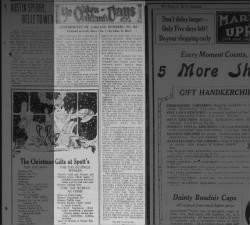.jpg)
Ye Olden Oakland Days
CONTRIBUTED BY OAKLAND PIONEERS - NO. 21
Oakland in Early Days (No. 7) by Chas. G. Reed
After 1854 and for a number of years, Oakland grew slowly, there being many hindrances to its growth. The school facilities were very inferior, only two or three Churches had been built and but one entirely completed, the First Baptist, at the southeast corner of Fifth and Jefferson streets. None of the streets had been improved and they were only beds of sand, making hard hauling for any kind of loaded vehicles during the summer; but they were fairly good in the winter, as there was little mud, the soil being sandy.
Land title disputes were almost endless and fraudulent titles multiplied. The city had accumulated quite a debt and the prospects which at first greeted the onward march of the new city, had considerably lessened. Some matters of importance were brought out, and after much talk and many threats to do this and that, they were finally settled in a fairly Just and amicable way
One of these matters was concerning the toll bridge between Oakland and Clinton (now East Oakland), where Twelfth street crosses at the foot of the lake. Before Alameda county was organized, a bridge had been party built by Contra Costa county, of which the present Alameda county was then a part, and in 1853 the Court of Sessions granted to Mr. Carpentier the privilege of finishing the bridge and of charging tolls, as follows: Each footman, 12 cents; each horse or cattle, 25 cents; each vehicle, 50 cents, etc.
The bridge was to be free from taxation of all kinds, Carpentier agreeing to surrender the bridge and make it free to the public at any time within twelve months upon payment to him of the original cost, together with interest at 3 per cent per month. Nothing in the grant to Carpentier was to be construed into an obligation on the part of the county to redeem the bridge or to refund the cost of construction, which was $12,519.56.
The Board of Supervisors, elected in 1855, took the place of the Court of Sessions, and one of the first acts of this body was the passage of a resolution declaring the bridge a public highway. They had no legal right to do this without first paying Carpentier for his outlay, but both the county and the city were decidedly anti-Carpentier, which was largely owing to his way of obtaining title to the waterfront. Under threats to build a bridge on Seventh street, and much controversy, the Board of Supervisors on October 5, 1857, paid Carpentier and his associates $6000 for their interest in the bridge, and it was then declared free to the public.
The bridge mentioned was built for most of the way across the salt marsh easterly from about the present Fallon street, but at the Clinton end the outlet to the lake was quite a deep waterway. Over there and just south of the bridge Captain Mickelsen had a wharf. Small vessels and light drift steamers ran up the arm of the estuary to this point, and in later years. Dr. Samuel Merritt maintained a lumberyard there. For a time a draw was used to let boats pass the Seventh street railroad bridge, but when the Southern Pacific bridge at First street was built, the draw was abandoned and Dr. Merritt moved his lumberyard to the foot of Washington street.
(To Be Continued)




